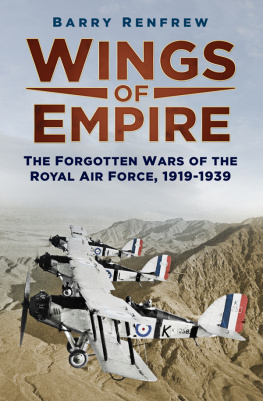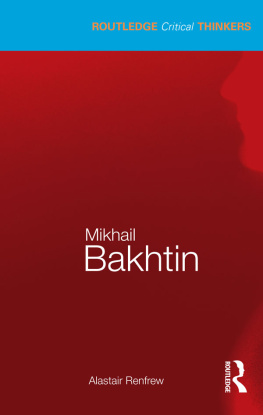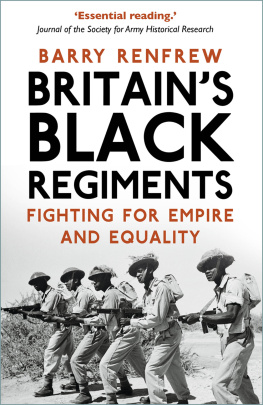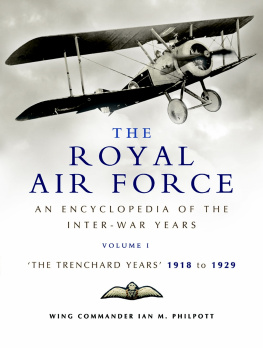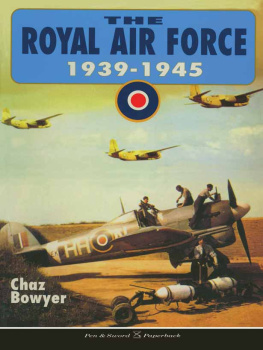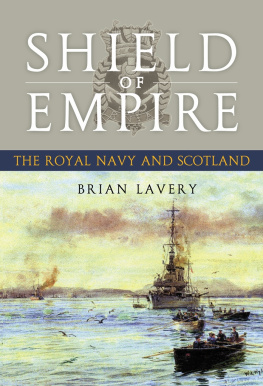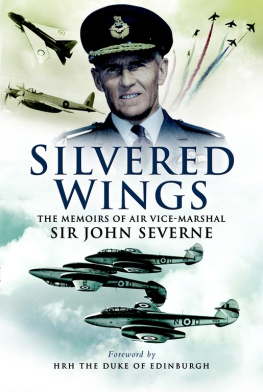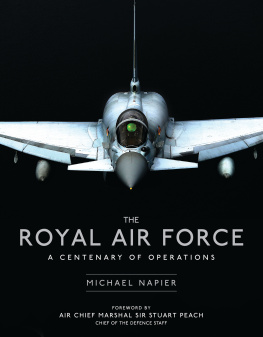Renfrew - Wings of empire the forgotten wars of the Royal Air Force, 1919-1939
Here you can read online Renfrew - Wings of empire the forgotten wars of the Royal Air Force, 1919-1939 full text of the book (entire story) in english for free. Download pdf and epub, get meaning, cover and reviews about this ebook. City: Stroud, year: 2019, publisher: Lightning Source Inc.;The History Press, genre: Politics. Description of the work, (preface) as well as reviews are available. Best literature library LitArk.com created for fans of good reading and offers a wide selection of genres:
Romance novel
Science fiction
Adventure
Detective
Science
History
Home and family
Prose
Art
Politics
Computer
Non-fiction
Religion
Business
Children
Humor
Choose a favorite category and find really read worthwhile books. Enjoy immersion in the world of imagination, feel the emotions of the characters or learn something new for yourself, make an fascinating discovery.
Wings of empire the forgotten wars of the Royal Air Force, 1919-1939: summary, description and annotation
We offer to read an annotation, description, summary or preface (depends on what the author of the book "Wings of empire the forgotten wars of the Royal Air Force, 1919-1939" wrote himself). If you haven't found the necessary information about the book — write in the comments, we will try to find it.
Wings of empire the forgotten wars of the Royal Air Force, 1919-1939 — read online for free the complete book (whole text) full work
Below is the text of the book, divided by pages. System saving the place of the last page read, allows you to conveniently read the book "Wings of empire the forgotten wars of the Royal Air Force, 1919-1939" online for free, without having to search again every time where you left off. Put a bookmark, and you can go to the page where you finished reading at any time.
Font size:
Interval:
Bookmark:




First published 2015
The History Press
The Mill, Brimscombe Port
Stroud, Gloucestershire, GL5 2QG
www.thehistorypress.co.uk
Barry Renfrew, 2015
The right of Barry Renfrew to be identified as the Author of this work has been asserted in accordance with the Copyright, Designs and Patents Act 1988.
All rights reserved. No part of this book may be reprinted or reproduced or utilised in any form or by any electronic, mechanical or other means, now known or hereafter invented, including photocopying and recording, or in any information storage or retrieval system, without the permission in writing from the Publishers.
British Library Cataloguing in Publication Data.
A catalogue record for this book is available from the British Library.
ISBN 978 0 7509 6689 4
Typesetting and origination by The History Press
Printed and bound in Great Britain by TJ International
eBook converted by Geethik Technologies
I chanced on the subject of Air Control while researching British colonial campaigns during the interwar period for another book. Little has been written about the subject despite the scale of the operations and the elaborate theories that underlay them. My efforts to find out more led to the writing of this narrative history. I benefited greatly from the studies of Charles Townshend, David Omissi and R.A. Beaumont.
The book is based on research at a number of museums and libraries, including the Royal Air Force Museum, the Imperial War Museum, the National Army Museum, and the National Archives at Kew. My thanks to the many remarkable and dedicated people who work at all of these fine places.
A small group of friends played a much bigger role than they probably realised in getting the book aloft with their unfailing help and encouragement. They include Jim Donna, Mike McHenry, Mark Shields, Bill Cranston, Donald Somerville and Wendell Hollis. I hope they will not be disappointed by the result.
I owe a special debt to Field Marshal Sir John Chapple. He has selflessly given of his time, experience and knowledge to inspire and assist people around the world in the study of military history.
My thanks to Michael Leventhal at History Press for taking on the book. Andrew Latimer and Lauren Newby did an excellent job of handling the manuscript.
And above all my thanks to Margaret, who inspired all that is good in these pages.
A solitary aeroplane with a 19-year-old English pilot at the controls raced down a crude runway hacked out of the Sudanese desert in the spring of 1916 as the first red flush of dawn peeled the darkness from the land. Lieutenant John Slessor flew west over the empty wastes, buffeted by low clouds and the desert wind. He wasnt sure how long he had been flying when he spotted a black smudge in the distance. As Slessor nosed lower, what at first looked like shadows cast by the clouds were transformed into a spectacle from the Crusades.
An army of Muslim horsemen arrayed in long, serried ranks stood in the desert below. Sunlight glinted on the riders steel helmets, gleaming breastplates and the tips of their lances; the wind ruffled their white robes; and green and black war flags emblazoned with verses from the Koran fluttered over their heads. It reminded Slessor of the toy soldiers he had played with as a child. For the rest of his life he never forgot the tragic beauty of that doomed army.
Few, if any, of the horsemen had seen an aeroplane before; some pointed and shouted in panic or astonishment, while others stared mutely as it roared over them. For a moment, Slessor was convinced he must seem like a winged god soaring across the sky. Shaking the distracting conceit from his mind, the young aviator began dropping bombs into the heart of the formation. Each blast tore gaping holes in the packed ranks of men and animals. Within minutes the army fractured into a terrified mob as thousands of men and animals bolted in every direction. Although barely noticed by a world transfixed by the titanic battles of the First World War, the defeat of a native army by a single aeroplane was the start of a revolution in British colonial warfare.
Aircraft were only added at the last minute when an expeditionary force was sent in 1916 against the Dervish sultanate of Darfur after it challenged British control of the Sudan. Such a thing had not been done before in British colonial warfare, but a senior official thought that it would terrify natives who had never seen an aeroplane.
Ground operations were already under way in the Sudan when the Royal Flying Corps (RFC) 17 Squadron in Egypt received an order on 29 March to provide a flight of four BE2c aircraft. The little wood and canvas planes were far too flimsy to fly the hundreds of miles to Darfur. Each machine had to be dismantled and packed in wooden crates to be transported by ship and then train. Along with them went a little contingent of nine officers and fifty-six men.
An airbase was built just inside Darfur at El Hilla, with an advance landing strip 50 miles further west at Abiad Wells. The landing strips were just bare earth cleared of rocks and shrub by gangs of Sudanese labourers with wooden tools and their hands. The only shelter against the sun and desert winds, which could warp or crack the planes wooden frames if left in the open for even a few hours, were two RFC canvas hangars and a marquee borrowed from the army.
Each tent had just enough space to house a single plane. Teams of mechanics and fitters worked for up to twelve hours at a time in the gloomy, stifling interiors. Poison was smeared on the canvas walls to keep out ants that could devour every part of an aeroplane except the engines and other metal components.
The 40 tons of fuel, weapons and spare parts needed for two weeks of operations had to be taken by camel over the last 100 miles to the airstrip at El Hilla. It took twenty-eight camels to transport the parts that made up each of the canvas hangars, and most collapsed and died after just a day or two.
At dawn on 11 May the first two planes, flown by Lieutenants F. Bellamy and Slessor, touched down at El Hilla. Watching Sudanese soldiers were awed. A British officer wrote in his diary:
For the first time astonished troops saw the beautiful sight of an aeroplane gleaming against a gold sunshine as it turned in a downward circle to land on the prepared stretch of ground. The ship of the air brought down the house. By God! Our General is very clever, murmured the marvelling soldiery.
The pilots had little time to appreciate such veneration; flying over the western Sudan was difficult and dangerous. Severe turbulence buffeted the frail aircraft and sandstorms, towering thousands of feet, appeared without warning and easily outraced the lumbering planes. Navigation over the desert was mostly guesswork: there were no reliable maps, and few hills or other natural features on the dun-hued landscape to steer by. Huge arrows of white calico cloth, 25ft long and 3ft wide, were positioned every 30 miles across the desert to stop crews going off course.
Font size:
Interval:
Bookmark:
Similar books «Wings of empire the forgotten wars of the Royal Air Force, 1919-1939»
Look at similar books to Wings of empire the forgotten wars of the Royal Air Force, 1919-1939. We have selected literature similar in name and meaning in the hope of providing readers with more options to find new, interesting, not yet read works.
Discussion, reviews of the book Wings of empire the forgotten wars of the Royal Air Force, 1919-1939 and just readers' own opinions. Leave your comments, write what you think about the work, its meaning or the main characters. Specify what exactly you liked and what you didn't like, and why you think so.

